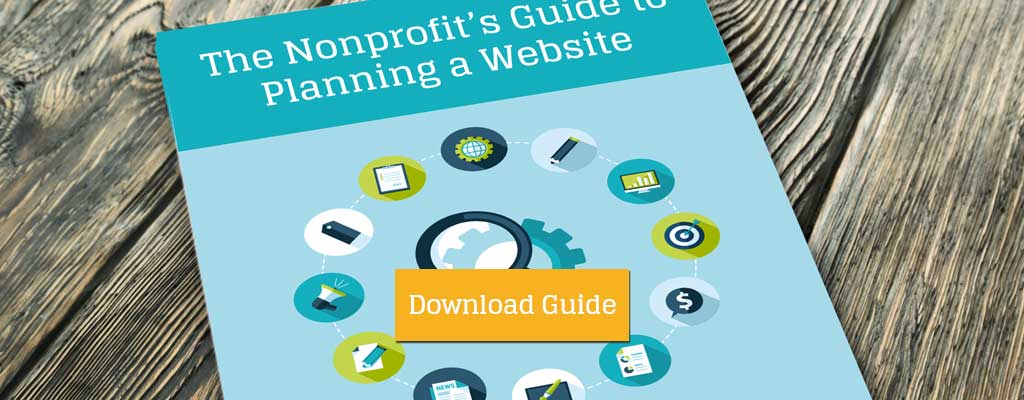
The Cheeky Monkey Media Blog
A few words from the apes, monkeys, and various primates that make up the Cheeky Monkey Super Squad.

Best Practices: Building Your Nonprofit’s Online Community
 January 24, 2017 / Treena Bjarnason
January 24, 2017 / Treena Bjarnason
In my recent guest post, I discuss why WordPress and Drupal are excellent content management system (CMS) choices for your nonprofit’s community website. Picking the right CMS is only the first step to building and nurturing a successful online community.
As Mack Fogelson writes in The Truly Monumental Guide to Building Online Communities:
Building an online community means identifying, reaching out to, and entering into a relationship with the online component of the diverse pieces that compose the sphere of your business [or nonprofit].
In other words, the key to a successful online community is to focus on building genuine relationships.
Building Genuine Relationships
In “9 Habits of People Who Build Extraordinary Relationships,” Jeff Haden notes that building great relationships means:
- Being able to take a hit.
- Stepping in without being asked.
- Answering questions that remain unasked.
- Knowing when to push, and when to dial it back.
- Thinking of others and showing it with your actions.
- Realizing when you have acted poorly and working to fix it.
- Giving consistently and accepting that this may not result in you getting anything back.
- Valuing not only the message but also the messenger.
- Starting small and being ok with remaining small.
While these traits look relatively simple on paper, they’re not always as simple to carry out.
Nevertheless, if you would like to build and nurture your community, each and every one of these concepts for developing and maintaining genuine relationships will need to to be at the forefront of your strategy.
Building your nonprofit’s online community
To help you achieve an online community that adheres to these principles, I’ve broken down the task into thirteen best practices:
1. Know who you are and what you would like to accomplish (with your online community and you’re nonprofit as a whole)
Defining Community
Belonging to a community in the current era no longer requires you to occupy the same geographical area. Rather, community implies a feeling of belonging and of “sharing some identity features … and rejecting others” (Ionescu-Tugui).
This doesn’t mean rejecting or villainizing those you don’t agree with. Instead, it’s about finding the threads that connect you and creating a niche.

Know yourself and your values
Now, before I get too academic on you (once an academic, always an academic?), this basically means knowing what your vision and purpose are. Or, as Fogelson puts it:
Know who you are, what you want your business [or nonprofit] to be. Find out what makes you and your business [or nonprofit] different and special …
And, don’t forget to ask, as Fogelson does, what you are “hoping to add to the world” with your organization.
Determine the purpose of your online community
Knowing your organization and your organization’s values are critical when you’re building an online community because it allows you to outline:
- What is important to your community?
- What your community wants to achieve.
- What collective values your community holds?
- Who you would like to participate in your community (your target audience).
2. Know your audience
I would prefer not to say too much on this matter because I think that as communicators we’ve discussed this one to death. The world gets it!
Just as you need to know and understand what is important to your organization, what motivates you, and what hinders your ability to succeed, you also need to know what motivates your target audience and what hinders their ability to succeed.
The best and most comprehensive way to get this information is to speak to your community members directly and create personas.
3. Know how much you are willing to put into building and growing your online community and nurturing it to success.
Here’s the thing, building and nurturing an online community takes time, effort, and financial resources.
Building and Maintaining Your Website
Regardless of which CMS you decide to use to host your online community, you will need to take the time to strategize the design, pay for server costs, and ensure your plugins (WordPress) or modules (Drupal) are up-to-date with the most recent security updates.
This is not a huge personnel, time, or financial expense, but it is one you should be aware of.
Creating and Sharing Valuable and Engaging Content
Second, if you’re going to build an online community, you’re going to need to create and share valuable content (see number 9). Even if you plan on curating content and relying heavily on user-generated content, you will still need to create some of your own content.
You are also going to need to take the time to source and moderate this content. Planning on having community members do this for you? This is a fantastic tactic and one you should certainly consider for your online community. However, you will still need to ensure that your community moderators are aware of and comfortable with community guidelines.
I don’t mean that you or any other member of the community should police content or “impose strict guidelines for interaction.” What I mean, is that if users are encouraged to submit user stories, you may need someone to review for spam, inflammatory language, and minor edits.
The bottom line?
If you aren’t willing to put the time in to participate in the conversation and nurture relationships with community members, don’t bother trying to build an online community. You won’t see success.

4. Get ready for the long haul. This is a long-term investment, not an exercise in instant gratification.
When you begin investing your time and resources into an online community, don’t expect to see results right away. At Cheeky Monkey, we use dating analogies a lot. So, here’s what I mean using dating as an example:
Let’s say you meet a man or woman you’re interested in, and ask them on a date. The date goes well. You can ask them on another date, but you can’t expect them to be willing to marry you right away. It takes time. For one, you need time to build that level of trust. For another, you need to cultivate a series of shared experiences. The list goes on, but you can probably see where I’m going with this.

The same goes when you’re building an online community. You need to take the time to get to know your community and give them time to get to know you. It doesn’t happen overnight.
Take the time to identify who to connect with and get to know them
First, you have to identify the individual or individuals you would like to connect with. Fogelson suggests you connect with:
- Current and potential customers (for nonprofits, this includes current and potential donors, volunteers, and those who receive support from your nonprofit).
- Peers.
- Industry innovators and experts.
- Other individuals you and members of your community respect and admire.
Next, you need to get to know these individuals. And, by getting to know them, I don’t mean hurl pieces of content at them. Connect with them online via social media, group chats, and forums, and, if possible, offline via phone calls, coffee meet-ups, or conference get-togethers.
Then, you have to engage with them. Share valuable information. Ask for their opinion. Acknowledge them and their ideas. Ask for feedback. Give feedback, when appropriate. Show genuine interest in their interests.
5. Remember that you’re building a community, not an army of mindless robotic supporters.
Your online community is not there at your beck and call. Ideally, you will aspire to be part of the community, not its dictator.
I love this quote from Zach Halmstad in the Entrepreneur,
You may have built the community and manage it, but you must recognize that it really belongs to the users.
If you’ve built your online community correctly, it will be based on a free-flowing dialogue that promotes a commitment to reciprocity.
6. For Pete’s sake, respond to people. But don’t just respond, listen, and seek to understand.
I’ve quoted Fogelson a few times already in this article, but I think she really hits the nail on the head, so I’ll refer to her again:
Relationships are the result of listening and responding. Of caring and taking the time to understand. Of providing valuable advice or insight. Of finding the balance between entertainment and profundity.
I can’t stress this enough.
Building a successful online community means engaging with your community and really listening, not just hearing.
Thus, while we should always be willing to question and dig deeper, we should never assume that we know what our community needs. Moreover, while we would like our communities to grow organically and ‘naturally’ moderate themselves, and they will, to a large extent, we still need to participate in the conversation. If we don’t, we stop being part of that community.
7. Consider your medium and tone. Not everyone communicates the same way.
When you are creating a website or hub for your online community, you need to consider how your target audience prefers to interact:
- Do they like reading and writing blogs?
- Are they comfortable sharing images?
- Do they like to leave comments?
- Is a forum appropriate?
- What about video?
Maybe they prefer a closed discussion group on Facebook?
Here, you need to be ready to question your assumptions.
For example, are you targeting the 40-yr-old to 50-yr-old demographic? Then you probably don’t want to use Snapchat or Instagram Stories as a tool. Right?
Maybe…
That would have been my assumption. However, this weekend I had a 50-something gentleman ask if I could take a picture of him, his wife, and another couple at the local ski resort. He wanted me to take the picture on Snapchat.
So, maybe a Snapchat or Instagram stories integration would be a good choice.
Take the time to understand how your audience communicates
I’m not saying you should use Snapchat or Instagram stories as part of your online community, or that you should take a Snapchat- or Instagram-stories- like approach to your communications. Rather, I invite you to take the time to research and test what form(s) of communication and what sort of tone and style of communication your target audience finds most approachable. After all, you want your community to enjoy interacting with you, not grow irritated with how difficult your website is to use.
8. Be professional, but personable.
Being professional, but personable is a fine line to walk. You don’t want to sound all awkward and official (your audience can read a legal brief if they want that experience), but you also don’t want to come across as someone that doesn’t take their work seriously.
The balance you strike will ultimately depend on your community and your values. At the end of the day, though, a good rule of thumb is to remember that you are engaging with an individual, not just a prospective donor, supporter, volunteer, or adversary.
- Throw in a joke every once in a while.
- Ask questions.
- Share a kind thought or word.
- Respond with compassion, not anger. Who knows, maybe someone left the toilet seat up and the individual fell into the toilet first thing in the morning, then got a flat tire on the way to work, and then poured coffee all over their brand new laptop. That’s a tad extreme, but you get my point.
9. Offer value.
Check out the infographic published on The Content Strategist by Nicole Dieker. In less than one minute:
- More than 1 million Facebook users like a post. 300 hours of YouTube videos are uploaded.
- More than 3 million text messages are sent.
- More than 300 thousand tweets are sent.
And, according to worldometers, more than three million blogs have been published today (September 9th, 2022) alone.
What I’m getting at is that if your content doesn’t add value to your community, your members will not care about it, and they will not actively engage with you.
What does quality content look like?
- Quality content is timely and relevant.
- Quality content answers un-asked questions.
- Quality content takes a new approach or perspective.
- Quality content inspires.
- Quality content is informed.
- Quality content acknowledges others and their options.
- Quality content is clear and concise, but dense.
10. Have a strategy in place for what you want to get out of your community, but don’t accept anything in return.
Like any initiative, you need to have a goal or series of goals for your online community. Whether these are lead goals (goals you can influence, i.e. connect with three people per day) or lag goals (goals you measure after the fact, i.e get 100 newsletter sign-ups in week one), you need to know what you would like to get out of your efforts.
But, you can’t expect anything from your community members. Your members don’t owe you anything. For example:
- That influencer you connected with? They are under no obligation to share your content or engage with you on your community website.
- That volunteer you gave a special shout-out to? They are under no obligation to volunteer again.
You’re going to have to give a lot before you can expect anything in return. Actually, it’s like giving a gift, you the gift because you would like to give a warm gesture, not because you would like a gift in return. Riiight?
11. Make it easy to share valuable insights that come out of your community.
Why do you want to build an online community?
I’m betting it’s for one or more of the following reasons:
- Engage and connect with your supporters or potential supporters.
- Get your nonprofit’s name out there to garner more support.
- Build awareness around your cause.
In order to achieve these goals, you need to make it easy for community members to share your content. An easy way to do this? Include social media share buttons on your content.
12. Measure efficacy, not just return on investment (ROI).
Here’s the deal, you probably have a business goal associated with your community website. That might be things like more sponsorships, higher donations, or more newsletter subscriptions. There is no shame in that. In fact, you should have these sorts of goals.
However, by its very name, a community website is so much more than that:
- It’s about the number and quality of interactions.
- It’s about how often people visit, and how much time they spend on your website.
- It’s about whether or not your community finds their experience valuable enough to share your content and come back for more. It’s about the number of people that contribute.
- It’s about the anecdotal feedback you receive. It’s about the number of mentions your receive.
So, remember, when measuring whether or not your community website is a success, remember to ask yourself not only what kind of impact it’s had on your fundraising efforts, but also what kind of impact it’s had on your ability to engage in interactive questions in your area of expertise.
13. Consider how you are going to facilitate engagement
As many nonprofit communicators have probably experienced, actually building an online community website is only the start. The real work comes after you’ve done all your research and built an online community website that stays true to your organization’s values and speaks to your target audience.
Bath Marshall, Director of Communications at the National Hemophilia Foundation (NHF), puts it the best:
Just because the site is done, doesn’t mean that you’re done. In fact, that’s when a lot of your work is going to begin. So make sure that you have the roles prepared on who is going to be finding relevant topics to post about; welcome new members; basically build a community. Building a website is easy – monkeys can do it! Building a community is hard.
To learn more about the NHF’s experience building their community website Victory for Women, check out my interview with their education and marketing crew coming out next week.
Thus, the most important thing you can do for your online community is to make sure that you have an individual in place who will be responsible for growing and nurturing your community. In other words, you need to have a community manager role or someone who can take on those responsibilities.
In Conclusion
It’s clear that building a thriving online community is no easy feat. If it was, we’d all have one and there would be no need for posts like this one. That said, just because something is hard, it doesn’t mean that you shouldn’t put in the time and effort to get it right. By following these 13 best practices, you will be well on your way to facilitating an online community that only increases brand loyalty, but also contributes meaningful conversations and insights to your cause.
Have additional thoughts you’d like to share? Tips and tricks that worked for you, or perhaps cautionary tales that you’ve learned from? Share them below. I’d love to hear from you.
Need additional resources to help you build your nonprofit website? Contact us today at [email protected]
